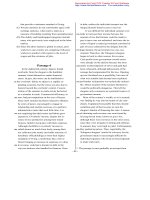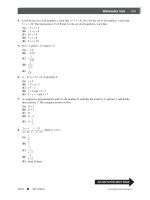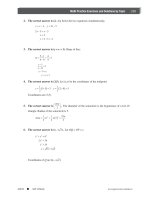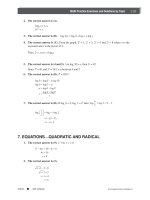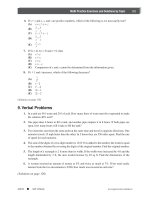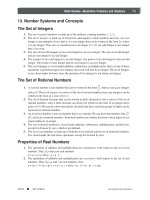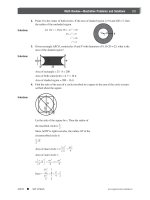SAT II Math Episode 1 Part 2 ppt
Bạn đang xem bản rút gọn của tài liệu. Xem và tải ngay bản đầy đủ của tài liệu tại đây (655.7 KB, 20 trang )
Outline of Topics 15
ARCO ■ SAT II Math www.petersons.com/arco
E. Graphs of trigonometric functions
1. Graphs of the sine, cosine, and tangent curves
2. Properties of the sine, cosine, and tangent curves
3. Definitions of amplitude, period, and frequency
4. Solving trigonometric equations graphically
F. Solutions of oblique triangles
1. Law of sines
2. Law of cosines
3. Using logarithms to solve oblique triangle problems
4. Vector problems—parallelogram of forces
5. Navigation problems
IX. MISCELLANEOUS TOPICS
A. Complex numbers
1. Meaning
2. Operations
a) Addition and subtraction
b) Multiplication and division
i. Powers of i
ii. Complex conjugate
3. Complex roots of quadratic equations
B. Number Bases
1. Converting from base 10 to other bases
2. Converting from other bases to base 10
3. Operations in other bases
C. Exponents and logarithms
1. Meaning of logarithms
2. Computation with exponents and logarithms
3. Equations
4. Graphs of exponential and logarithmic functions
D. Binary operations
1. Definition of binary operations
2. Properties of binary operations
3. Application to modular arithmetic
E. Identity and inverse elements
1. Addition
2. Multiplication
3. Other operations
Part
III
17
ARCO ■ SAT II Math www.petersons.com/arco
MATH REVIEW—ILLUSTRATIVE PROBLEMS
AND SOLUTIONS
1. Formulas and Linear Equations
An equation is a statement that two mathematical expressions are equal.
In the equation 3x + 4 = 19, the 3, 4, and 19 are called constants, the letter x the variable. When
solving an equation we try to find the numerical value (or values) of the variable that makes the equality
true. In 3x + 4 = 19, the value x = 5 is the root or solution of the equation. In this equation the highest
exponent of x is 1, and so we call such an equation a first degree equation. It is also called a linear
equation, since its graph is a straight line.
The basic principle of solving equations is the following:
Addition, subtraction, multiplication, or division (except by 0) of both sides of an equation by the
same number results in an equivalent equation, i.e., one with the same root or roots.
To solve 3x + 4 = 19, start by subtracting 4 from both sides.
Now divide both sides by 3.
To solve fractional equations, first multiply both sides of the equation by the least common denomi-
nator (LCD) of all fractions in the equation.
To solve
, multiply both sides of the equation by 15, the least common denominator (LCD).
Substitution of 30 for y in the original equation serves as a check of the answer.
Part III18
www.petersons.com/arco ARCO ■ SAT II Math
A formula is an equation usually involving a relationship between literal quantities. Problems
involving formulas often require substitution in a formula and solution of the resulting equation for a
particular variable.
If the formula is entirely literal and the problem calls for solving for one variable in terms of the
others, start by moving all terms containing this variable to one side of the equation.
The area, A, of a triangle is given by the formula:
To solve for h, multiply both sides by 2.
Illustrative Problems
1. In the formula , find C when F = 68.
Solution: Substitute 68 in the formula.
Subtract 32 from both sides.
Multiply both sides by 5.
180 = 9C
C = 20
2. Solve the formula
for t.
Solution: Multiply both sides by a + t.
s(a + t) = at
as + st = at
Subtract st from both sides.
as = at – st
Factor the right side.
3. In the formula V = πr
2
h, if r is doubled, what must be done to h to keep V constant?
Solution: If r is doubled, the effect is to quadruple V, since the r is squared in the formula. Hence,
h must be divided by 4 to keep V the same in value.
Math Review—Illustrative Problems and Solutions 19
ARCO ■ SAT II Math www.petersons.com/arco
Solution: 4. A package weighing 15 lb is sent by parcel post. It costs x cents for the first 10 lb and
y cents for each additional lb. Express the cost, C, in terms of x and y.
The first 10 lb cost x cents; the remaining 5 lb cost 5y cents. The total cost C is given by
the formula:
C = x + 5y
5. Solve for m: 2m + 7 = m – 9
Solution: Subtract m and 7 from both sides.
6. Solve for y:
Solution: Multiply both sides by 12 (LCD).
7. Solve for n: an = 5 + bn
Solution: Subtract bn from both sides.
Now factor on the left side.
n(a – b) = 5
Divide both sides by (a – b).
2. Algebraic Fractions
To simplify or multiply algebraic fractions with binomial or polynomial terms, first factor the polynomial
completely, and then divide out factors that are common to both numerator and denominator of the frac-
tion or fractions.
To divide algebraic fractions, write the divisor as its reciprocal and proceed as in multiplication.
To add or subtract algebraic fractions, rewrite the fractions as equivalent fractions with the same
least common denominator (LCD), and then add like fractions as in adding arithmetic fractions.
In the following illustrative problems, we assume that the variables do not take values that make the
denominator zero.
Part III20
www.petersons.com/arco ARCO ■ SAT II Math
IIllustrative Problems
1. Simplify to lowest terms:
Solution: Factor numerator and denominator.
Divide numerator and denominator by the common factor, y – 5.
2. Multiply:
Solution: Factor numerators and denominators.
Divide numerators and denominators by common factors x, (x - y), (x + y).
3. Divide:
Solution: Write second fraction as its reciprocal and multiply.
4. If a man buys several articles for n cents per dozen and his selling price is cents per
article, what is his profit, in cents, on each article?
Solution:
Least common denominator is 36.
Math Review—Illustrative Problems and Solutions 21
ARCO ■ SAT II Math www.petersons.com/arco
5. Simplify:
Solution: Write each expression in parentheses as a single fraction.
6. Simplify:
Solution: Multiply numerator and denominator by x
2
.
7. Simplify:
Solution: Factor the numerator.
8. If , x > 0, what effect does an increase in x have on y?
Solution: As x increases,
decreases. Therefore, we are subtracting a smaller quantity from 1, and
consequently y increases.
3. Sets
The solution set of an open sentence is the set of all elements in the replacement set of the variable that
makes the open sentence a true sentence.
The intersection of two sets P and Q (P ∩ Q) is the set of all elements that are members of both
P and Q.
The union of two sets P and Q (P ∪ Q) is the set of all elements that are members of either P or Q.
Two sets are said to be disjoint sets when their intersection is the empty set. (P ∩ Q = ∅)
The complement of a set P is the set P´ of all members of the universal set that are not members of P.
Part III22
www.petersons.com/arco ARCO ■ SAT II Math
Illustrative Problems
1. How many elements are in the set: {x|3 < x < 9, x is an integer}?
Solution: The indicated set contains only the elements 4, 5, 6, 7, and 8, or 5 elements.
2. If A is the set of all prime numbers and B the set of all even integers, what set is repre-
sented by A ∩ B?
Solution: The only even prime integer is 2.
A ∩ B = {2}
3. Find the solution set of the equation x
2
= 3x if x is the set of real numbers.
Solution:
The solution set is {0, 3}
4. Find the solution set of 3x – 4 > x + 2 where x is the set of the real numbers.
Solution:
5. Find the solution set of the system: A = {(x,y)| x
2
+ y
2
= 25} and B = {(x,y)| y = x + 1}
Solution: Substitute y = x + 1 into the first equation.
Thus x + 4 = 0 or x – 3 = 0 so that x = – 4 or x = 3.
When x = – 4, y = –3 and when x = 3, y = 4.
A ∩ B has two elements: (3, 4) and (– 4, –3)
Math Review—Illustrative Problems and Solutions 23
ARCO ■ SAT II Math www.petersons.com/arco
4. Functions
A function is a set of ordered pairs (x, y) such that for each value of x, there is one and only one value of
y. We then say that “y is a function of x,” written y = f(x) or y = g(x), etc. The set of x-values for which the
set is defined is called the domain of the function, and the set of corresponding values of y is called the
range of the function.
y is said to be a linear function of x if the two variables are related by a first-degree equation, such as
y = ax + b where a ≠ 0 and b is any real number.
y is said to be a quadratic function of x if y can be expressed in the form y = ax
2
+ bx + c where a ≠ 0
and b and c are real numbers.
In general, y is said to be a polynomial function of x if y can be expressed in the form:
where the exponents are nonnegative integers and the coefficients (c
0
, c
1
, c
2
,…c
n
) are real numbers.
When we speak of f(a), we mean the value of f(x) when x = a is substituted in the expression for f(x).
The inverse of a function is obtained by interchanging x and y in the equation y = f(x) that defines the
function. The inverse of a function may or may not be a function. A procedure that is often used to find the
inverse of a function y = f(x) is to interchange x and y in the equation that relates them, and then to solve
for y in terms of x, if possible.
If z = f(y) and y = g(x), we may say that z = f[g(x)]. Thus z is in turn a function of x. In this case we
may say that z is a composite function of f and g and is also written f · g = f[g(x)]. For example, if
z = f(y) = 3y + 2 and y = g(x) = x
2
, then z = f[g(x)] = 3 [g(x)] + 2 = 3x
2
+ 2.
Illustrative Problems
1. If f(x) = x
2
+ 2x – 5, find the value of f(2).
Solution: Substitute x = 2 in the polynomial.
2
2
+ 2(2) – 5 = 4 + 4 – 5 = 3
2. If f(y) = tan y + cot y, find the value of
.
Solution:
3. If F(t) = t
2
+ 1, find F(a – 1).
Solution: Substitute t = a – 1.
Part III24
www.petersons.com/arco ARCO ■ SAT II Math
4. If f(x) = 2x + 3 and g(x) = x – 3, find f[g(x)].
Solution: In f(x), substitute g(x) for x.
5. What are the domain and range of the function y = |x|?
Solution: The function is defined for all real values of x. Hence the domain is {x| – ∞ < x < + ∞; x
is a real number}.
Since y = |x| can only be a positive number or zero, the range of the function is given by the set
{y | 0 ≤ y < + ∞; y is a real number}.
6. If
(A) f ( –t) (B) (C) (D) (E) none of these
Solution: (A)
(B)
(C)
The correct answer is (D).
Math Review—Illustrative Problems and Solutions 25
ARCO ■ SAT II Math www.petersons.com/arco
7. Find the largest real range of the function .
Solution:
The range for y consists of all real numbers except y = 1.
8. Write the inverse of the function f as defined by
.
Solution: Let
. Substitute x for y, and y for x.
9. If =
Solution:
Hence
10. If the functions f and g are defined as f(x) = x
2
– 2 and g(x) = 2x + 1, what is f [g(x)]?
Solution:
Part III26
www.petersons.com/arco ARCO ■ SAT II Math
5. Exponents
The following formulas and relationships are important in solving problems dealing with exponents (x ≠ 0 in
all cases that follow):
where m and n are integers, n ≠ 0
In scientific notation a number is expressed as the product of a number between 1 and 10 and an
integral power of 10. This notation provides a convenient way of writing very large or very small numbers
and simplifies computation with such numbers. For example, if a certain star is 780 billion miles from the
earth, we write this number as 7.8 × 10
11
. The eleventh power of 10 indicates that the decimal point in 7.8
is to be moved 11 places to the right.
If the diameter of a certain atom is 0.00000000092 cm., we write this number as 9.2 × 10
–10
. The –
10, as a power of 10, indicates that the decimal point is to be moved 10 places to the left.
This method of writing large and small numbers is consistent with the laws of exponents above.
These laws also facilitate computation with very large or very small numbers when written in scientific
notation, as illustrated in some of the problems below.
Illustrative Problems
1. Find the value of 2x
0
+ x
2/3
+ x
–2/3
when x = 27.
Solution: Substitute x = 27.
Math Review—Illustrative Problems and Solutions 27
ARCO ■ SAT II Math www.petersons.com/arco
2. If y = 3
x
, 3
x+2
=
(A) y
2
(B) 2
y
(C) y + 3
(D) 9y
(E) y + 9
Solution: (D)
3. If 0.00000784 is written in the form 7.84 × 10
n
, what does n equal?
Solution: Writing the number in scientific notation, we get 0.00000784 = 7.84 × 10
–6.
n = –6
4. The length of an electromagnetic wave is given by the formula , , where C is the
velocity of light (3 × 10
10
cm per sec) and F is the frequency. What is the value of L when
F = 3000 megacycles per sec?
Solution: F = 3000 × 10
6
= 3 × 10
9
Substitute in formula.
5. Solve the exponential equation:
Solution:
Since the bases are equal, equate the exponents.
6. If 4
y
= 125, between what two consecutive integers does y lie?
Solution:
Since 125 is between 64 and 256 and 4
y
is a steadily increasing function, y is between 3
and 4.
Part III28
www.petersons.com/arco ARCO ■ SAT II Math
7. Solve the equation:
Solution:
Since the bases are equal, the exponents may be set equal.
8. Solve for x:
Solution:
9. Solve for r:
(A) 1
(B) 2
(C) 3
(D) 4
(E) 5
Solution: (D)
If the bases are equal, the exponents are equal.
Math Review—Illustrative Problems and Solutions 29
ARCO ■ SAT II Math www.petersons.com/arco
10. Find the value, in simplest form, of the fraction
.
(A)
(B)
(C)
(D)
(E)
Solution: (E)
6. Logarithms
Definition: The logarithm of a number to a given base is the exponent to which this base must be raised
to yield the given number.
log
b
N = e is equivalent to b
e
= N. For example, the equation 5
3
= 125 may be written log
5
125 = 3.
For computational purposes we usually use 10 as the base; if we write log n, the base 10 is understood.
Logarithms to base 10 are called common logarithms.
The function inverse to the function y = b
x
, b > 0, b ≠ 1 is y = log
b
x. We define the logarithmic
function of x at this point only for positive values of x.
The laws of logarithms are derived from the laws of exponents. They are listed below for base 10
although they apply to any acceptable base.
Although common logarithms are generally used for computation, logarithms to base e are used in
more advanced work, particularly in calculus. The constant e = 2.7183 … is an irrational number and is
significant in the study of organic growth and decay. The function y = e
x
is usually called the exponential
function.
Part III30
www.petersons.com/arco ARCO ■ SAT II Math
Illustrative Problems
1. Find the value of log
4
64.
Solution: Let x = log
4
64. In exponential notation,
2. If log 63.8 = 1.8048, what is log 6.38?
Solution:
3. If log 2 = a and log 3 = b, express log 12 in terms of a and b.
Solution:
4. In the formula A = P(1 + r)
n
, express n in terms of A, P, and r.
Solution:
5. If log t
2
= 0.8762, log 100t =
Solution:
Math Review—Illustrative Problems and Solutions 31
ARCO ■ SAT II Math www.petersons.com/arco
6. If log tan x = 0, find the least positive value of x.
If log tan x = 0, then tan x = 1.
Therefore
7. If log
a
2 = x and log
a
5 = y, express log
a
40 in terms of x and y.
Solution:
8. Find log
3
.
(A) 3
(B) 1
(C)
(D)
(E) none of these
Solution: (C)
7. Equations—Quadratic, Radical, and Exponential
An equation of the second degree is called a quadratic equation. The general form of the quadratic equa-
tion in one variable is
ax
2
+ bx + c = 0 where a, b, and c are real numbers and a ≠ 0.
In order to solve a quadratic equation, express it in its general form and attempt first to factor the
quadratic polynomial. Then set each linear factor equal to zero. This procedure produces two roots, which
in some cases are equal.
If the quadratic member of the equation ax
2
+ bx + c = 0 is not factorable, we apply the quadratic
formula:
The quantity under the radical sign, b
2
– 4ac, is called the discriminant (D) of the quadratic equa-
tion; it determines the nature of the roots of the equation.
If D = b
2
– 4ac is a positive quantity, the two roots are real. If D is a negative quantity, the roots are
imaginary. If D = 0, the roots are real and equal. If D is a perfect square, the roots are real and rational.
Part III32
www.petersons.com/arco ARCO ■ SAT II Math
The roots, r
1
and r
2
, of the general quadratic equation ax
2
+ bx + c = 0 are related to the coefficients
of the equation as follows:
An equation containing the variable under a radical sign is called a radical equation. In a radical
equation both members may be squared, or raised to any power, to eliminate radicals. This procedure may
introduce extraneous roots; all roots obtained by this method must be checked in the original equation.
When the variable in an equation appears as an exponent in one or more terms, we call the equation an
exponential equation. One approach in solving such equations is to try to write the terms to the same base.
Since the bases are the same, we may now equate the exponents.
In more involved exponential equations it is often helpful to take the logarithm of both members.
In solving a pair of simultaneous equations in two variables, try to eliminate one of the unknowns
and solve for the other.
Illustrative Problems
1. Find the roots of the equation
.
Solution: Factor the left member.
Either
2. Solve the following system of equations:
Math Review—Illustrative Problems and Solutions 33
ARCO ■ SAT II Math www.petersons.com/arco
Solution: Substitute the value of x from the second equations into the first.
Group the roots.
3. Find the nature of the roots of the equation: 2x
2
– 4x – 3 = 0.
Solution: Discriminant
Since D is positive but not a perfect square, the roots are real, unequal, and irrational.
4. Solve the equation:
Solution: Square both sides.
It is essential that these roots now be checked in the original equation. Substitute y = 11
in the equation.
,which checks.
Now substitute y = 18.
This value does not check so y = 11 is the only root.
Part III34
www.petersons.com/arco ARCO ■ SAT II Math
5. For what value of a in the equation ax
2
– 6x + 9 = 0 are the roots of the equation equal?
Solution: Set the discriminant equal to zero.
6. If 2 is one root of the equation x
3
– 4x
2
+ 14x
2
– 20 = 0, find the other two roots.
Solution: Use synthetic division.
The resulting equation is x
2
– 2x + 10 = 0.
Solve by the quadratic formula.
7. Find K so that 5 is a root of the equation y
4
– 4y
3
+ Ky – 10 = 0.
Solution: Substitute y = 5 into the equation.
8. Find all positive values of t less than 180° that satisfy the equation 2 sin
2
t – cos t – 2 = 0.
Solution: Substitute 1 – cos
2
t for sin
2
t.
9. Find the remainder when x
16
+ 5 is divided by x + 1.
Solution: If f(x) = x
16
+ 5, then the remainder is equal to



